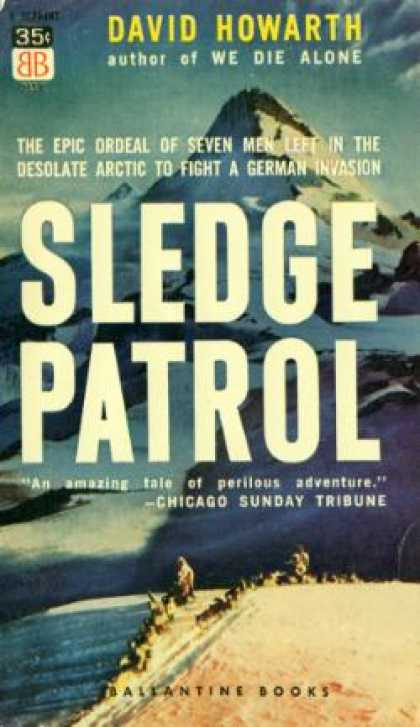Review: The Sledge Patrol July 6, 2010
Author: Beach Combing | in : Contemporary , trackback
Beachcombing has been delighted at the volume of correspondence for his story about Kurt the last combatant of the third Reich. Kurt though was only one of several score warriors in ‘the Weather Wars’, a largely overlooked chapter in the history of the Second World War. From1940 the Nazis were infiltrating their meteorologists into the northern Atlantic – Spitsbergen, Greenland, Lapland and, yes, Canada – in an attempt to find out what weather fronts their continental armies might expect. And the Allies, employing Norwegian and Danish patriots, tried to deprive the Nazis of this crucial information using skis, dog sleds and anything else at their disposal, in some of the most hostile landscapes known to man.
Beachcombing fell in love with the Weather Wars many years ago reading David Howarth’s The Sledge Patrol (1956) that relates the facts of one particularly interesting battle in that war in the winter of 1942-1943 on the north-eastern coast of Greenland. The battle was not particularly bloody by the standards, say, of Stalingrad, taking place at the same time, a third of the way around the globe. In fact, it was not particularly bloody compared with a punch-up in a sawdust bar. Only one man died – a stupid and unnecessary death owing to a faulty machine gun magazine: and only two prisoners were taken, both of whom could reasonably have been accused of desertion. Indeed, it is a miracle – though a happy one – that David Howarth managed to find any publisher for this story: there is no action movie here.
The true hero of the book is north-eastern Greenland, the ice-locked coast that stretches from the 70-76 parallel and on which perhaps twenty five men had hunted in pre-war times. It is a quiet, meditative wintry territory – ‘he had never been so aware of the presence of God’ – where even the placenames, the detritus of five or six different languages, have a gentle quality: Scoresby Sound, Geographical Society Island, Kaiser Franz Joseph Fiord, Eskimoness, Hochstetter Bay…
The armies fighting over this vast territory are two. The Allies: half a dozen Scandinavians and Eskimos patrolling the coast on their sleds to prevent German penetration. The Axis: about a score of German naval, scientific and army personnel put ashore to set up a weather observation station and to warn the Reich whenever storm clouds are on the way. The Allies are bad at war but good at northern Greenland and subsisting there. The Axis are brilliant fighters but useless in snow and ice, having had very little Arctic experience. These parallel incompetences mean that the two sides rarely come to blows, though not for want of trying, and that the greatest enemy is not man but frostbite.
So why read the book of this failed battle in an obscure war? Well, Beachcombing never needs an excuse to luxuriate in the forgotten corners of history. But for those who do not share his malaise it should be said that David Haworth (obit 1991) accidentally wrote a novel. His meditations on the meaninglessness of ideology in a freezing, inhospitable world underpin the actions of the warriors on both side, who cannot hide from their consciences and end up by assisting each other to survive the elements.
A detail that is worth a thousand words: after the war the most accomplished of the Allied patrolmen, Peter Nielsen, attempted to help, his old enemy and sometime prisoner, Lieutenant Ritter, the German leader out of financial difficulties at home.
Any more Weather Wars publications or articles or memories? drbeachcombingATyahooDOTcom



